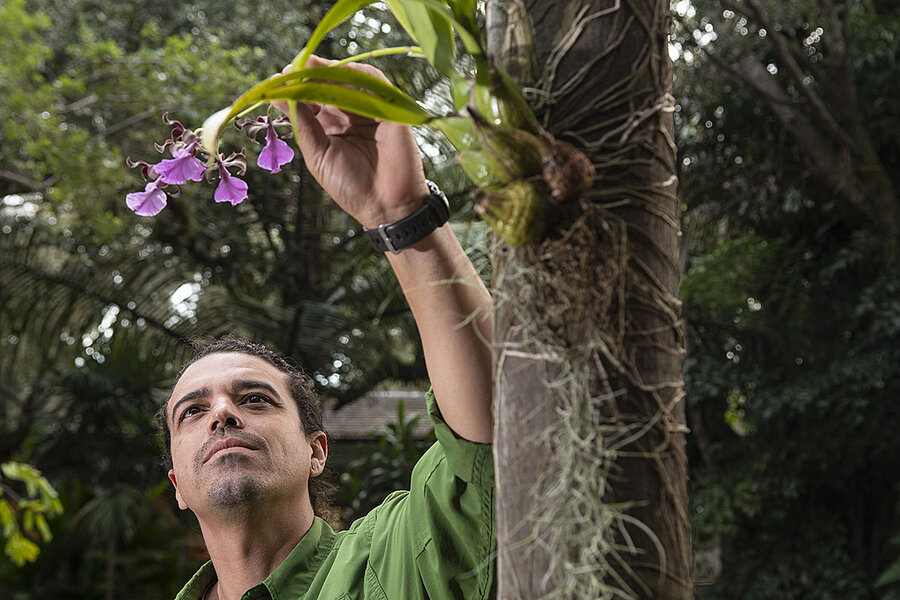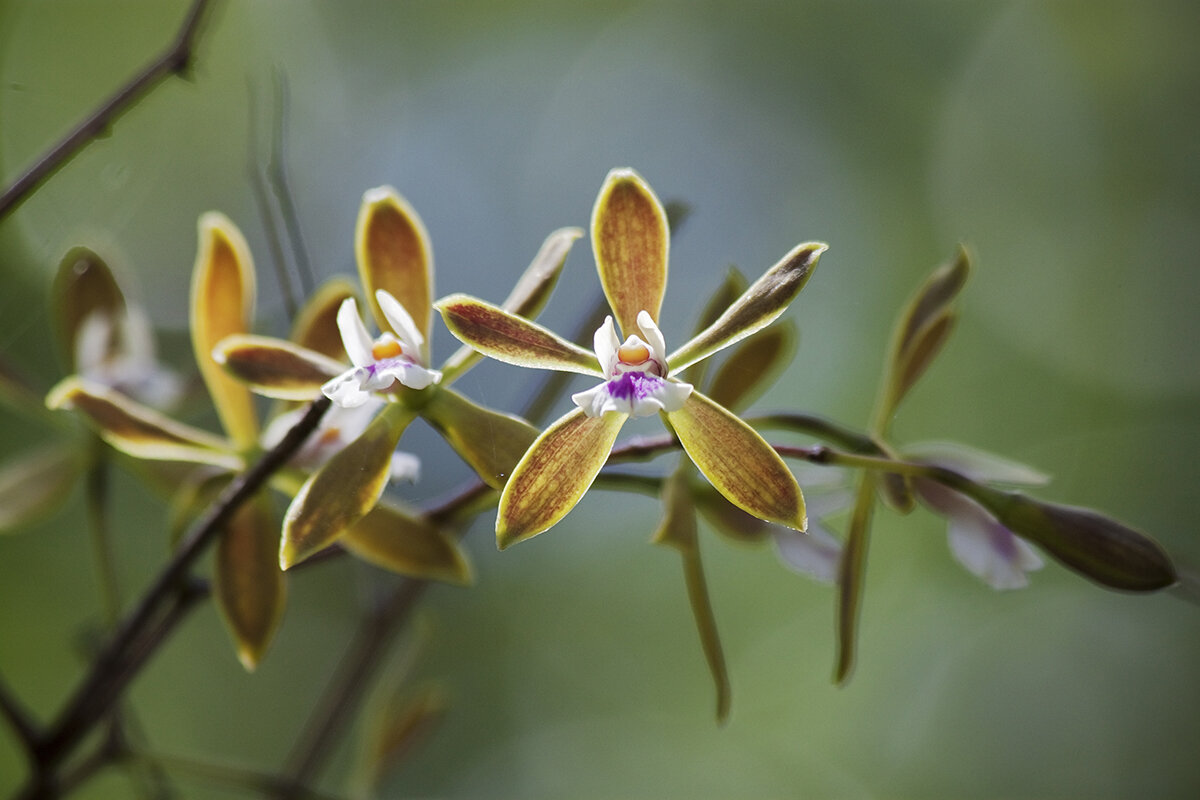The orchid whisperers: Rare blooms find an urban perch
Loading...
| Miami
It’s not what you might imagine a conservation site to be. Hammering and drilling echoes through the Downtown Doral Park from a high-rise construction project nearby. Children clamber around a playset. Trash blows across neatly mowed grass. Planes fly low overhead, their engines roaring.
The only indication that anything unique is afoot is a small metal identification card dangling from some of the trees in the postage stamp-sized municipal park. Amid the strings of decorative lights wrapped around those trees, the leaves of rare, native orchid plants flutter in the wind. Their roots grip the bark, almost dripping down the branches.
Encyclia tampensis orchids once flourished unaided in South Florida. Today, they are extremely rare in the wild, due to shrinking habitat and rampant exploitation in the orchid trade of decades past. But conservationists are working to restore populations of native orchids to the region.
Why We Wrote This
Can planting endangered plants in urban settings help heal the disconnect between humans and nature? Conservationists in Miami are trying a fresh approach to both landscaping and saving native plants.
Plant conservation projects typically happen far from urban areas, where people are less likely to destroy the delicate seedlings. But a team of scientists at Fairchild Tropical Botanic Garden in Coral Gables, Fla. is trying a fresh approach: integrate native plants into human-dominated spaces, including school yards, hospital campuses, city parks, and even alongside busy roads.
“With habitat loss and climate change, we’re seeing our natural areas shrinking by the day,” says Jason Downing, the orchid biologist at Fairchild who is spearheading the project. “So it’s going to be critical that the future generations are clever and inventive and innovative in the ways that we try to preserve biodiversity. And one of those ways is working in less natural areas, in semi-natural areas and urban areas.”
The Million Orchid Project, as it is called, is part of a broader push to reintegrate native plants into urban environments. And such an approach diverges from typical conservation thinking.
Humans often relate to nature as something wild and separate from society, that has to be protected. But that perspective might be changing.
“I'm starting to see a real switch in people’s perceptions about nature,” says Desirée Narango, a postdoctoral researcher at the Advanced Science Research Center at the City University of New York and visiting researcher at the University of Massachusetts Amherst.
“There was a tendency to completely transform an area to this manicured lawn with particular non-native plants,” she says, but over the past decade or so, ecologists and home gardeners alike are thinking more about urban areas as ecosystems.
A new mindset
As humans develop a landscape, the habitat that previously supported many native species disintegrates, squeezing many of those organisms out.
When people plant non-native plants in their yards, and weed out the natives, wildlife suffers, too, Dr. Narango explains. And she’s not just talking about raccoons and deer. Insects such as butterflies and bees often rely on specific plants. These, in turn, attract birds, which can munch on bugs that people don’t want around, such as mosquitoes and ticks.
When native plants are reintroduced, other organisms return as well, sometimes even creatures that had been feared lost. The reintroduction of the coontie plant to South Florida, for instance, resulted in the reappearance of the Atala butterfly, which had been thought extinct.
The coontie’s low maintenance and appealing foliage made it an easy sell to locals. Orchids have similar selling points, but some native plants have been dismissed for landscaping because they don’t fit the traditional mold.
“If we want our ecosystems to be richer, more diverse, more abundant, and have a healthier ecology, then we will also have to get comfortable with the fact that that ecosystems don’t always meet our sometimes narrow ideas of beauty,” says Timon McPhearson, associate professor of urban ecology and director of the Urban Systems Lab at the New School in New York.
It’s about finding beauty in the natural systems, he says, even when that means plants appear dead during winter, for example.
Planting native species in an urban environment isn’t always simple. Just ask Dr. Downing at Fairchild.
In the case of the Floridian orchids, cultivation can take two to four years, depending on the species. And it’s not as simple as sticking a seed in some dirt or on a tree.
Orchid seeds actually can’t germinate on their own. In the wild, they have a symbiotic relationship with fungi that fuels germination. But in the lab, the scientists must feed the baby orchids with nutrients themselves.
Once the young plants have grown large enough and have been hardened to survive outside a greenhouse, Downing’s team of volunteers, students, and citizen scientists must find a suitable place to put them. In the city, that can be tricky, as many orchids need particular native trees to thrive.
The project has only been under way for a few years, so Downing can’t say yet whether transplanted orchids will seed the next generation of urban orchids. But through the propagation process, he is learning more about what each species needs to better target his efforts.
Finding harmony with nature
A lot more research around native plants in urban environments is needed, says Christopher Swan, a professor of community ecology at the University of Maryland, Baltimore County. And a big question remains: how much work needs to go into maintaining them?
Professor Swan has studied how readily some native plants can take hold and reseed the next generation unaided in a vacant plot of urban land in Baltimore. His results have been mixed: Many native species can recolonize the area, but not all of them. Soil quality has a lot to do with how well these plants can survive, he says.
The conversation around planting natives is part of a broader effort to make cities more green in general. New York City, for example, has converted an old railroad spur into an elongate park (which is great for connectivity of habitat, by the way). Green roofs are also increasing in popularity. And cities are looking for more places to build parks.
This doesn’t have to be about returning unused urban areas to nature’s wild grasp, says Narango. Instead, it’s about finding harmony for humans and other parts of the natural world within the concrete jungle of cities.
“A yard in the middle of the city may not mimic interior forests,” she says. “But we can get darn close to providing resources and still maintaining a yard that is providing services for us, too,” like a place for children to play.
[Editor's note: This story has been updated to correct the university affiliation of Christopher Swan. He is a professor at the University of Maryland, Baltimore County.]







